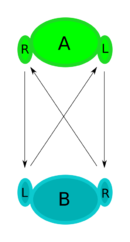2 juggler vanilla passing siteswap
This is exactly the same as vanilla siteswap described for two hands, only difference is that the beats are distributed over four hands.
Hand Order
The hand order commonly used is: JugglerA(R), JugglerB(R), JugglerA(L), JugglerB(L).
So the pattern always alternates between JugglerA and JugglerB on each beat and each juggler has thows alternating between left, right, left, right, left… hand.
Global Pattern vs Local Pattern
The global pattern is just what we have just described. A siteswap used to describe a pattern on four hands. But two passers both want to know only their own "role" in the pattern, not what happens globally.
For that, we need to split the global pattern into throws for JugglerA and throws for JugglerB. This is easy, as the pattern always alternates between JugglerA and JugglerB - so every 2nd number belongs to one partner.
Example:
77722 is the global pattern. Let's write this as 7772277722 (double length). Now every other number belongs to the same juggler. We do:
7 7 7 2 2 7 7 7 2 2 A 7 7 2 7 2 B 7 2 7 7 2
So JugglerA gets the throw sequence 77272 and JugglerB gets the sequence 72772.
We can then make the sequence appear even more like a two-handed vanilla siteswap by dividing all numbers by 2. This way we ignore the beats that happen at the other passer.
So 77272 becomes
3.5 3.5 1 3.5 1
Now all passes to the other person show a half beat away, because the other juggler's hands do their throws in between the throws of my hands. All other throws that only happen on my side look exactly like a two-handed vanilla siteswap.
Typical Throws (with Clubs)
Mind, that siteswap only determines when an object is thrown again. Not the exact time for flight nor the spin of a club.
That said, the relations in this table cover about 99% of all cases of asynchronous siteswap patterns nicely.
| Global | Local | Name | Abbr. |
|---|---|---|---|
| 0 | 0 | empty hand | 0 |
| 1 | 0.5 | only used in chipmonk patterns | |
| 2 | 1 | zip | Z |
| 3 | 1.5 | hand over /give | G |
| 4 | 2 | hold or flip | F |
| 5 | 2.5 | zap/joey pass | J |
| 6 | 3 | self | S |
| 7 | 3.5 | single pass | P |
| 8 | 4 | heff | H |
| 9 | 4.5 | double pass | D |
Siteswap Generator App
The siteswap geneator for android (play store link F-droid link ) app was made to find new assymetric vanilla 4-hand patterns (and others), but can also be used as a "notebook" of patterns. It does the necessary steps shown above to get from a global to two local patterns for two people. It additionally shows a possible way to start the pattern and two diagrams.
Example 77722:
Tap on "enter siteswap" and enter 77722, you should see the following:

- First line shows the global pattern
- The arrows left and right of the pattern makes the app suggest different starts if you don't like the pattern begin given here
- "Local Siteswap" gives instructions for jugglers A and B.
- juggler A always begins half a beat before B (also seen in diagram below)
- both jugglers start with the right hand (also seen in diagram below)
- A1|2: Juggler A starts with 1 club in the left hand and 2 clubs in the right hand
- 3.5; 1; 3.5, 3.5; 1 is the throw sequence for A. Here: pass zip pass pass zip
- the small parallel lines "||" mean straight passes, the small x means crossing passes
- You can usually ignore the diagrams. They are useful if you have a problem with the pattern and can't work out what it is.
- Ladder Diagram//Siteswap Diagram: The diagram shows the way of each object, each arrow points to the beat given by the siteswap number later. If a 7 is thrown, the arrow points to the hand that throws 7 beats later
- Causal Diagram: Arrows point to the hand/throw that is caused by the object. Like "This throw has to be done so I have a free hand to catch the object" .
passist.org
Throughout this wiki, I am using animations provided by Christian H. via passist.org. Many thanks to him for this excellent tool to make my wiki information more tangible to people. Since 2024 you can also install passist.org on your phone as a web-app for offline use.
